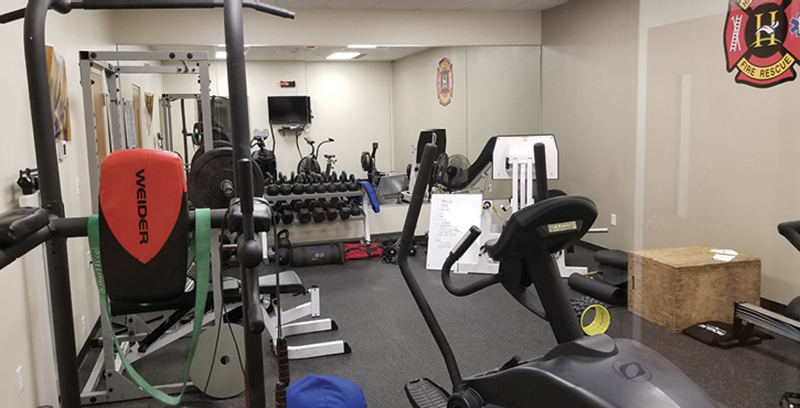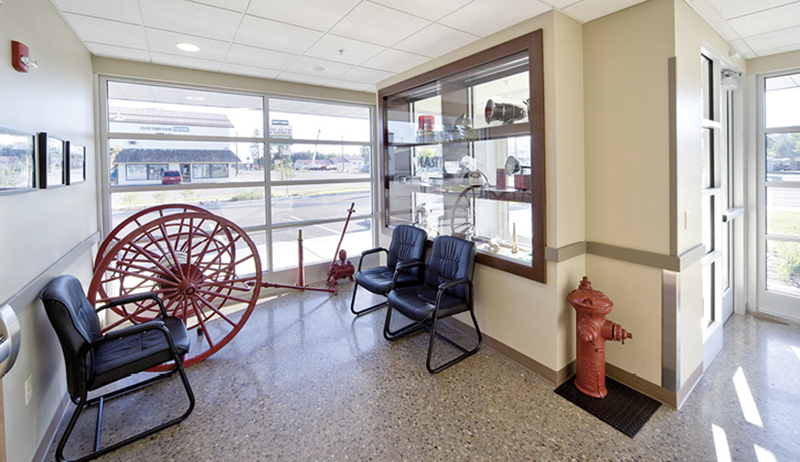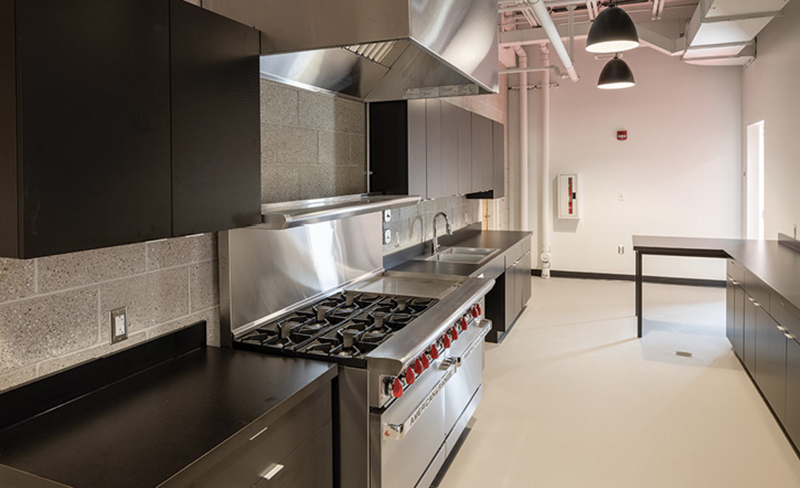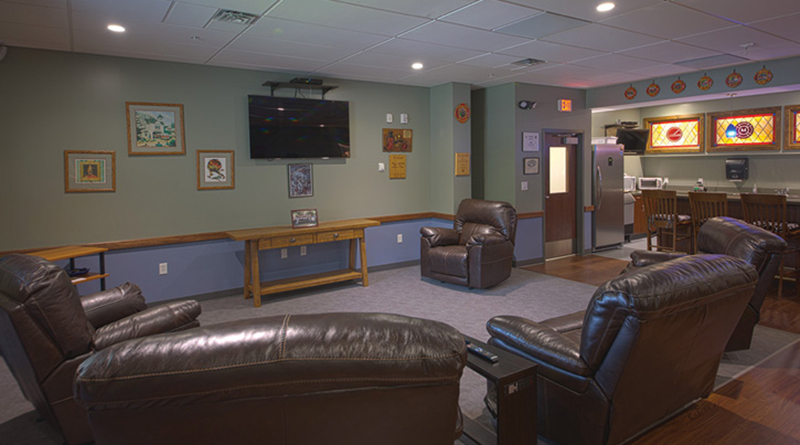Fire station designers and architects are taking special care with new stations in terms of keeping contaminants away from firefighters’ living spaces and contained in areas labeled hot zones where contaminated gear and equipment are cleaned and stored. There are a number of types of flooring available to them that best fit those considerations.
Scott Csendes, director of public facilities for KZF Design, points out that with concerns about carcinogens getting into living areas and with the COVID-19 pandemic, many fire departments switched from carpeting in living areas to either sealed concrete or luxury vinyl tile (LVT) flooring. “We are putting in a lot more LVT, which has some padding to it, is easy to clean and sterilize, helps a bit with acoustical issues, and is available both as a sheet product and in plank form,” Csendes says.
“If a department chooses concrete in the living area, there are different ways it can be finished,” he notes. “The lowest end is concrete sealed with a polymer, which has more of an industrial look and has to be resurfaced every three to five years. The middle grade would be an epoxy finish on the concrete, where the epoxy has some thickness to it, can be opaque or colored, is easily cleaned, and is relatively bulletproof to stains. Another method is where the concrete is treated by acid washing or grinding a fraction of the top to flatten it, giving the concrete a pebbly look. Often, we’d put a stain on top of that for color and to give it texture.”
Kevin Spector, chief creative officer for SMP Design, says many departments are choosing hard, seamless surfaces for their living spaces, including dorms, day rooms, kitchens, offices, and conference areas. “We’re seeing a preference for polished concrete, where it’s ground and polished to a satin finish that’s easily cleaned and seamless,” Spector says.
SMP also has seen a trend toward using LVT in fire stations. “These wood-look planks glue down like vinyl tile and are especially popular in eating and office areas and in sleeping spaces,” he says. “It is softer underfoot than concrete, butts together tightly to form nonseams as good as sheet vinyl, and is a very popular material.” The one place where Spector says SMP sees a little carpet being used is in a station’s main vestibule. “We install an outdoor-grade carpet that has the job of pulling material off the soles of boots and shoes,” he notes. “Sometimes the area has a polished concrete floor and then the department has an outside service bring in an area carpet mat that can be replaced with a clean one at intervals.”
Ken Newell, principal at Stewart-Cooper-Newell (SCN) Architects, agrees that the trend in station floors is toward hard surfaces. “Durability and maintenance-free flooring are the driving forces, along with preventing the transfer of contaminants, viruses, and particulates,” Newell observes. “When departments get rid of carpet, they get rid of allergen and mold issues.” Newell notes that SCN also is seeing a lot of use of LVT in station living areas. “It’s a very cost-effective product, is easy to maintain, and doesn’t require any stripping or waxing,” he says.
Besides LVT, SCN also recommends the use of sealed or polished concrete or epoxy finished concrete. “They are not zero maintenance,” he adds, “and depending on the surface and the sealer used, they must be retreated at certain intervals. But they are available in variations of colors, textures, and patterns.” Newell says SCN also has been using Kinetics, a carpet-like product that has plastic fibers made from recycled water bottles. “The fibers are drawn out and stand horizontal, so they don’t allow things to collect into it,” Newell says. “The product looks and feels like carpet and gives sound qualities like carpet but cleans like a vinyl floor. It’s great for those who want a carpet feel but something that acts like vinyl.” He notes SCN has been installing Kinetics in training rooms, dorms, and offices.

1 SMP Design used an epoxy resin over concrete in this fire station bathroom. (Photos 1-2 courtesy of SMP Design.)

2 SMP installed rubber mat flooring in this fitness/exercise room.

3 SCN Architects put in grouted porcelain tile in this firefighter bathroom for the Raleigh (NC) Fire Department. (Photos 3-4 courtesy of Stewart-Cooper-Newell Architects.)

4 SCN put in terrazzo flooring in the high-traffic lobby area of Evergreen (MT) Fire Department Station No. 81.
Klindt Breckenridge, principal in Breckenridge Group Architects Planners, says 90% of the flooring his firm has installed in fire stations has been a semi-gloss type of sealed concrete, both in living spaces and apparatus bays. “In some kitchens we’ve put in sheet vinyl and in other areas have installed LVT, which is harder and more durable than sheet vinyl,” Breckenridge says.
In exercise rooms, Breckenridge has installed interlocking half-inch-thick rubber flooring and sometimes 50-inch-wide Mondo roll flooring, which also interlocks. He notes that the weight of the rubber flooring holds it down in place so there is no need to glue it. He adds that for the Chandler (AZ) Fire Department, his firm put in terrazzo shower stalls in the bathroom spaces but that typically he puts in sealed concrete or tile on bathroom and shower floors.
Bob Mitchell, principal at Mitchell Associates Architects, says his firm has found that sheet linoleum, where the joints can be made virtually seamless, is very popular in living spaces like kitchens, dining areas, bathrooms, and other places. “We sometimes use LVT, which is a high-quality product that performs very well but is more expensive than linoleum,” Mitchell notes. “We also use a product called Flotex, which is composed of very short nylon fibers and is available in both tile and sheet form.”

5 Breckenridge Group Architects Planners put in a semi-gloss sealed concrete floor in the apparatus bays at this Chandler (AZ) Fire Department station. (Photos 5-6 courtesy of Breckenridge Group Architects Planners.)

6 Breckenridge used luxury vinyl tile flooring in the area leading to the fire pole in Scottsdale (AZ) Fire Department Station 616.

7 The Galante Architecture Studio installed linoleum flooring in this fire station kitchen for the Onset (MA) Fire Department. (Photos 7-8 courtesy of The Galante Architecture Studio.)

8 Galante put in a polished concrete floor in the day room at the Davenport (IA) Fire Department’s Central Fire Station.
Pete Signorelli, Mitchell’s director of architecture, says that they have used porcelain tile and ceramic mosaic tile, especially in the toilet rooms for firehouse public lobbies. “For the firefighter living spaces, we use a fine-grit epoxy over concrete in the shower and toilet rooms,” Signorelli notes.
Yar Laakso, senior associate at The Galante Architecture Studio, says his firm has used linoleum and LVT in kitchen and day room areas and rubber flooring in either sheets or tiles in exercise areas and other living spaces. “All these finishes can be cleaned easily,” Laakso observes, “and the rubber products are some of the best materials for longevity.”

9 Mitchell Associates Architects installed a combination of Flotex and LVT flooring in this members’ day room for the Midway (NY) Fire Department. (Photos 9-10 courtesy of Mitchell Associates Architects.)

10 Mitchell put in linoleum flooring in the Purchase (NY) Fire Department’s ready/radio room.
Paolo Carissimi, a Galante principal, says Galante installs carpet in bunk rooms or other areas if that is the fire department’s requirement. “In some cases, they will use tile in place of carpet,” Carissimi notes, “especially in bathrooms and locker rooms, but with grouted tile, the grout needs to be sealed on a regular basis.” He adds that for the Cambridge (MA) Fire Department, Galante put epoxy sealed concrete floors in the kitchen and bathrooms. “Polished concrete is another type of seamless floor that’s easy to clean and resists contamination,” he says. “We try to eliminate any type of floor that might retain particles and carcinogens.”
In apparatus bays and other hot and warm zones in a fire station, Csendes says the three types of finished concrete used in living spaces can be used in the bays, depending on the look the department wants. “Some departments don’t want clear sealer that shows concrete markings underneath, so they’ll go with an epoxy flooring with a much heavier thickness than an interior finish to withstand the heavier use in the apparatus bays,” he says. “We also have installed layover mats in apparatus bays, two- by two-foot square tiles made of polymers that interlock with each other. We usually put them in the areas where the apparatus wheels run, but some departments do the entire bay area with the tiles.”
Spector says that while SMP has done one fire station apparatus bay with an epoxy floor over the concrete, it has done many more projects where the apparatus bays have polished concrete floors with a special penetrating sealant made for commercial garage floors. “It’s a vehicle-grade sealant that doesn’t allow oil or other fluids to penetrate,” he says. “Also, you want something that is nonslip and robust enough to take the weight and wear from the fire vehicles.”
Newell notes that his opinion on the best flooring for apparatus bay floors and adjacent support spaces is based on more than 400 fire station projects. “We like to start with a basic concrete that’s troweled in, then sealed with a primary sealer and finished with a final sealer,” he says. “The texture and finish of the flooring are somewhere in between a sidewalk and a slick finish.” Apparatus bay floors can be ground, polished, and sealed for a durable finish, Newell adds, or have an epoxy finish. “We’ve found that epoxy often doesn’t perform well over time,” he says. “The hard top coat has to be maintained, and many epoxy finishes don’t like having hot tires on them. Also, they are not warranteed for ultraviolet (UV) protection, so if you have a lot of glass in your station doors or leave the doors open frequently, you can get fading of the floor colors.”
Signorelli says that in apparatus bays “you don’t want a finish on the floor that promotes slips and falls but also that is so granular that it’s hard to keep clean. Finishes come in macro and micro scale, where the macro has larger quartz or sand granules embedded in the epoxy. You want to be on the higher end of the friction scale in apparatus bays and lower in the accessory spaces.”

11 Sika Corp. used its Fast-Set polyaspartic sealant on the apparatus bays in this Centre Square (PA) Fire Company station. (Photos 11-12 courtesy of Sika Corp.)

12 This firehouse bathroom concrete floor was sealed with Sika Corp.’s Fast-Set sealant.
He points out that before his firm puts down epoxy in an apparatus bay, they scour the surface to rough it up, often using a procedure called blast cracking.” “We want the epoxy primer to soak down into the minute cracks made by the blast cracking,” Signorelli says, “so it penetrates and locks into the many fingers or pathways of those small cracks.”
Carissimi says the recent trend in apparatus bay floors is a seamless flooring with an anti-slip surface. “We use epoxy because it’s easy to clean and maintain and can be raised up the wall so there is no seam,” Carissimi says.
Jim Ziegler, technical manager for Sika Corp., says that while Sika makes polyurethane and epoxy sealants for concrete floors, it also makes a polyaspartic sealant that cures quickly and is a much thicker product. “A sheet of writing paper is 3 mills thick, and polyurethane and epoxy go down at 4 to 8 mills thick,” Ziegler says. “Our polyaspartic, called Fast-Set, goes down 15 mills thick and takes only two hours to cure, compared with overnight for polyurethane. This allows for a rapid return to service of the apparatus.”
Ziegler notes that Fast-Set “is impervious to water, chemicals, soap, sanitizer, oil, transmission and brake fluids, fuels, and maintenance oils. A fire department can expect one covering to last 20-plus years.”
ALAN M. PETRILLO is a Tucson, Arizona-based journalist, the author of three novels and five nonfiction books, and a member of the Fire Apparatus & Emergency Equipment Editorial Advisory Board. He served 22 years with the Verdoy (NY) Fire Department, including in the position of chief.

